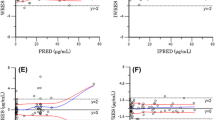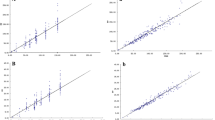Abstract
Background and objectives
Ceftazidime and amikacin are often prescribed concomitantly to treat infections caused by Gram-negative bacteria. Their physicochemical properties are quite similar. Both drugs are highly soluble in water, have low plasma protein binding and are >95% excreted unchanged by the kidney via glomerular filtration. Their pharmacokinetic parameters are therefore expected to correlate. This study was performed to explore the correlation between the pharmacokinetic parameters of these two drugs.
Patients and methods
Patients at Phramongkutklao Hospital, Bangkok, Thailand, who met the inclusion criteria participated in the study. They all received ceftazidime and amikacin concomitantly to treat their infections. After steady-state conditions had been reached, two blood samples were collected during the elimination phase of both drugs. Plasma drug concentrations were analysed and the pharmacokinetic parameters of each drug were calculated. The pharmacokinetic parameters that were examined included total drug clearance (CL), the elimination rate constant (ke), the elimination half life (t½) and the volume of distribution (Vd). The correlations of the pharmacokinetic parameters of amikacin and ceftazidime were determined using regression analysis.
Results
Regression analysis showed that the pharmacokinetic parameters of ceftazidime and amikacin were highly correlated. The correlation coefficients (r) of CL, ke, t½ and Vd of the two drugs were 0.966, 0.943, 0.888 and 0.671, respectively. The correlation between amikacin clearance and ceftazidime clearance was higher than the correlation between either amikacin or ceftazidime clearance and creatinine clearance, for which the r values were 0.647 and 0.661, respectively.
Conclusions
The pharmacokinetic parameters of ceftazidime and amikacin were highly correlated. Knowledge of the pharmacokinetic parameters of one of these drugs can be used to predict the pharmacokinetic parameters of the other drug.




Similar content being viewed by others
References
Laethem Y, Lagast H, Klastersky J. Serum bactericidal activity of ceftazidime and cefoperazone alone or in combination with amikacin against Pseudomonas aeruginosa and Klebsiella pneumoniae. Antimicrob Agents Chemother 1983; 23(3): 435–9
De Jongh C, Joshi J, Newman K. Antibiotic synergism and response in Gram-negative bacteremia in granulocytopenic cancer patients. Am J Med 1986; 80 Suppl. 5C: 96–100
Calandra T, Cometta A. Antibiotic therapy for Gram-negative bacterimia. Infect Dis Clin North Am 1991; 5: 817–34
EORTC International Antimicrobial Therapy Cooperative Group. Ceftazidime combined with a short or long course of amikacin for empirical therapy of Gram-negative bacteremia in cancer patients with granulocytopenia. N Engl J Med 1987; 317: 1692–8
Hollander J, Horrevorts A, Goor M, et al. Synergism between tobramycin and ceftazidime against a resistant Pseudomonas aeruginosa strain, tested in an in vitro pharmacokinetic model. Antimicrob Agents Chemother 1997; 41(1): 95–100
Song W, Woo H, Kim J, et al. In vitro activity of beta-lactams in combination with other antimicrobial agents against resistant strains of Pseudomonas aeruginosa. Int J Antimicrob Agents 2003; 21: 8–12
Karakoc B, Gerceker A. In-vitro activities of various antibiotics, alone and in combination with amikacin against Pseudomonas aeruginosa. Int J Antimicrob Agents 2001; 18: 567–70
Cometta A, Zinner S, de Bock R, et al. Piperacillin-tazobactam plus amikacin versus ceftazidime plus amikacin as empiric therapy for fever in granulocytopenic patients with cancer. Antimicrob Agents Chemother 1995; 39(2): 445–52
Cometta A, Calandra T, Gaya H, et al. Monotherapy with meropenem versus combination therapy with ceftazidime plus amikacin as empiric therapy for fever in granulocytopenic patients with cancer. Antimicrob Agents Chemother 1996; 40: 1108–15
Richards D, Brogden R. Ceftazidime a review of its antibacterial activity, pharmacokinetic properties and therapeutic use. Drugs 1985; 29: 105–61
Van der Auwera P. Pharmacokinetic evaluation of single daily dose amikacin. J Antimicrob Chemother 1991; 27 Suppl. C: 63–71
Garraffo R, Drugeon H, Dellamonica P, et al. Determination of optimal dosage regimen for amikacin in healthy volunteers by pharmacokinetics and bactericidal activity. Antimicrob Agents Chemother 1990; 34(4): 614–21
Marik P, Havlik I, Monteagudo F, et al. The pharmacokinetics of amikacin in critically ill adult and paediatric patients: comparison of once-versus twice-daily dosing regimens. J Antimicrob Chemother 1991; 27 Suppl. C: 81–9
Leggett J. Aminoglycoside therapy current and prospective uses. Tex Heart Inst J 1990; 17(4): 330–6
Hoffler D, Koeppe P, Williams K. The pharmacokinetics of ceftazidime in normal and impaired renal function. J Antimicrob Chemother 1983; 12 Suppl. A: 241–5
Welage L, Robert W, Schentah J. Pharmacokinetics of ceftazidime in patients with renal insufficiency. Antimicrob Agents Chemother 1984; 25(2): 201–4
Ackerman B, Ross J, Tofte R, et al. Effect of decreased renal function on the pharmacokinetics of ceftazidime. Antimicrob Agents Chemother 1984; 25(6): 785–6
Rains C, Bryson H, Peters D. Ceftazidime: an update of its antibacterial activity, pharmacokinetic properties and therapeutic efficacy. Drugs 1995; 49(4): 577–617
Sommers DK, Walters L, Van Wyk M, et al. Pharmacokinetics of ceftazidime in male and female volunteers. Antimicrob Agents Chemother 1983; 23: 892–6
Alestig K, Trollfors B, Andersson R, et al. Ceftazidime and renal function. J Antimicrob Chemother 1984; 13: 177–81
LeBel M, Barbeau G, Vallee F, et al. Pharmacokinetics of ceftazidime in elderly volunteers. Antimicrob Agents Chemother 1985; 28(5): 713–5
Beringer P, and Winter ME. Aminoglycoside antibiotics. In: Winter ME, editor. Basic clinical pharmacokinetics. Philadelphia (PA): Lippincott, William & Wilkins; 2004: 130–71
Amikacin package insert. Abbott Park (IL): Abbott Laboratories Diagnostics Division, 2003
Papp E, Knupp CA, Barbhaiya RH. High-performance liquid Chromatographic assays for the quantification of amikacin in human plasma and urine. J Chromatogr 1992; 574: 93–9
Isla A, Arzuaga A, Maynar J, et al. Determination of ceftazidime and cefeprime in plasma and dialysate-ultrate from patients undergoing continuous veno-venous hemodiafiltration by HPLC. J Pharm Biomed Anal 2005; 39(5): 996–1005
Hane S, Wood G, Herring V, et al. Intermittent and continuous ceftazidime infusion for critically ill trauma patients. Am J Surg 2000; 179: 436–40
Pea F, Viale P, Daniela D, et al. Ceftazidime in acute myeloid leukemia patients with febrile neutropenia: helpfulness of continuous intravenous infusion in maximizing pharmacodynamic exposure. Antimicrob Agents Chemother 2005; 49(8): 3550–3
Gomez C, Cordingly J, Palazzo M. Altered pharmacokinetics of ceftazidime in critical ill patients. Antimicrob Agents Chemother 1999; 43(7): 1798–802
Hassan E, Ober J. Predicted and measured aminoglycoside pharmacokinetic parameters in critically ill patients. Antimicrob Agents Chemother 1987; 31(1): 1855–8
Bressolle F, Gouby A, Martinez J, et al. Population pharmacokinetics of amikacin in critically ill patients. Antimicrob Agents Chemother 1996; 40(7): 1682–9
Zeitany R, Saghir N, Santhosh-Kumar C, et al. Increased aminoglycoside dosage requirements in hematologic malignancy. Antimicrob Agents Chemother 1990; 34(5): 702–8
Etzel JV, Nafziger AN, Bertino JS. Variation in the pharmacokinetics of gentamicin and tobramicin in patients with pleural effusions and hypoalbuminemia. Antimicrob Agents Chemother 1992; 36(3): 679–81
Gilman TM, Brunnemann SR, Segal JL. Comparison of population pharmacokinetic models for gentamicin in spinal cordinjured and able-bodied patients. Antimicrob Agents Chemother 1993; 37(1): 93–9
Segal JL, Brunnemann SR, Gordon SK, et al. Amikacin pharmacokinetics in patients with spinal cord injury. Pharmacotherapy 1988; 8(2): 79–81
Wragge T, Cooper B. Correlation of aminoglycoside and vancomycin pharmacokinetic parameters. Ann Pharmacother 1993; 27: 1346–8
Welch L, Leader W, Chandler M. Predicting vancomycin pharmacokinetics by using aminoglycoside pharmacokinetics. Clin Pharm 1993; 12: 909–13
Beringer P, Wong-Beringer A, Rho J. Predictive performance of a vancomycin-aminoglycoside population model. Ann Pharmacother 1998; 32: 176–81
Leader W, Andria M, Kessel K. Relationships between aminoglycoside and vancomycin pharmacokinetics in patients with hematopoietic stem-cell transplants. Am J Health-Syst Pharm 1999; 56: 161–4
Piccoli L, Larosa M, Marchetti F. Time-kill curves as a tool for targeting ceftazidime serum concentration during continuous infusion. J Antimicrob Chemother 2003; 52: 1047–8
Mouton JW, den Hollander JG. Killing of Pseudomonas aeruginosa during continuous infusion and intermittent infusion of ceftazidime in an in vitro pharmacokinetic model. Antimicrob Agents Chemother 1994; 38: 931–6
Alou L, Aguilar L, Sevillano D, et al. Is there a pharmacodynamic need for the use of continuous versus intermittent infusion with ceftazidime against Pseudomonas aeruginosa? An in vitro pharmacodynamic model. J Antimicrob Chemother 2005; 55: 209–13
Nicolau D, McNabb J, Lacy M, et al. Continuous versus intermittent administration of ceftazidime in intensive care unit patients with nosocromial pneumonia. Int J Antimicrob Agents 2001; 17: 497–504
Zarowitz B, Robert S, Peterson E. Prediction of glomerular filtration rate using aminoglycoside clearance in critically ill medical patients. Ann Pharmacother 1992; 26: 1205–10
Acknowledgements
The authors are grateful to Chulalongkorn University, Bangkok, Thailand, for financial support, Siam Pharmaceutical Co. Ltd, Bangkok, for supplying ceftazidime, all physicians, nurses and nurse aides in the medical and surgical wards and the staff of the laboratory and blood blank at Phramongkutklao Hospital, Bangkok, for their helpfulness. No sources of funding were used to assist in the preparation of this study. The authors have no conflicts of interest that are directly relevant to the content of this study.
Author information
Authors and Affiliations
Corresponding author
Rights and permissions
About this article
Cite this article
Panomvana, D., Kiatjaroensin, SA. & Phiboonbanakit, D. Correlation of the Pharmacokinetic Parameters of Amikacin and Ceftazidime. Clin Pharmacokinet 46, 859–866 (2007). https://doi.org/10.2165/00003088-200746100-00004
Published:
Issue Date:
DOI: https://doi.org/10.2165/00003088-200746100-00004




